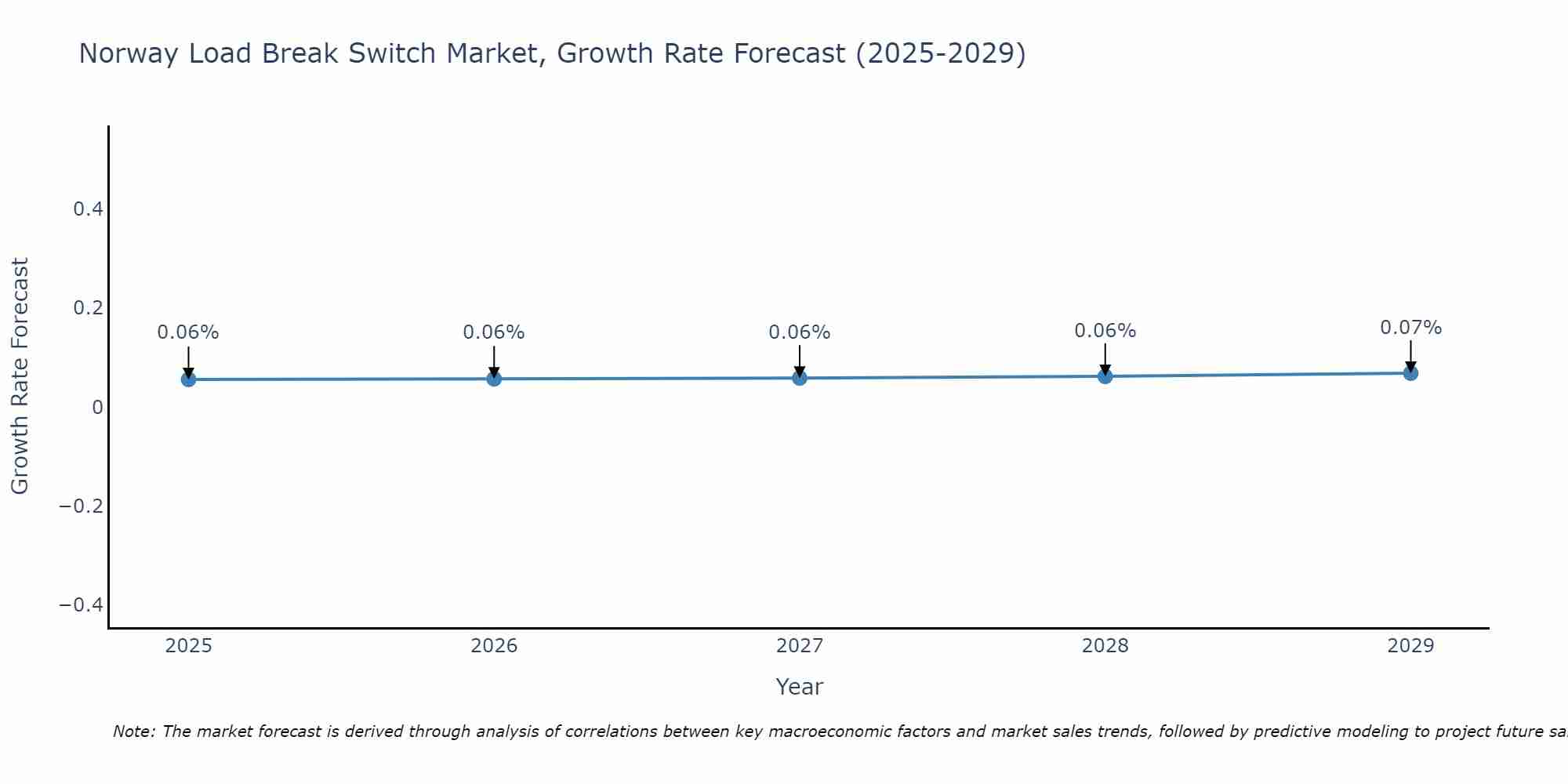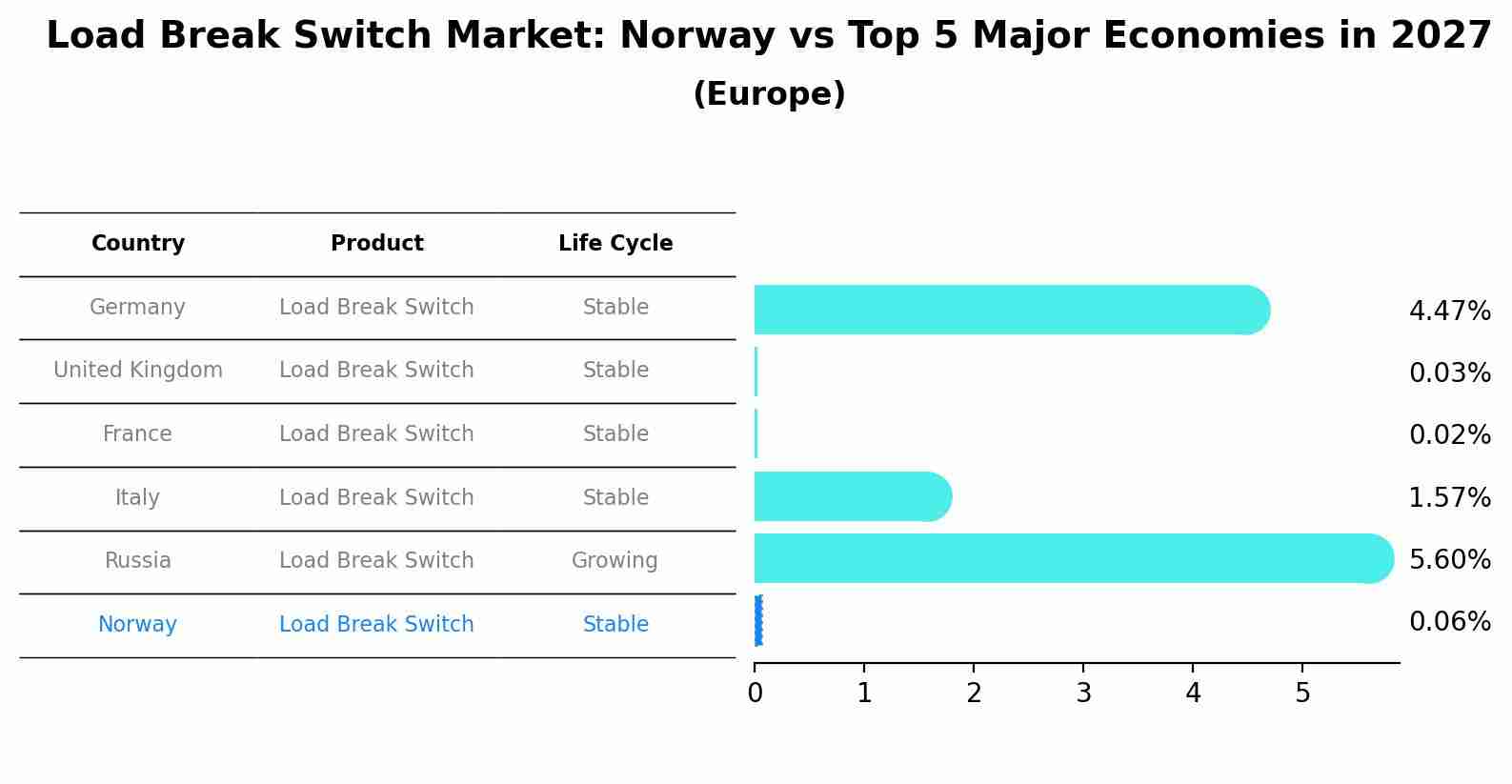Norway Load Break Switch Market (2025-2031) | Value, Forecast, Revenue, Outlook, Segmentation, Analysis, Growth, Share, Companies, Trends, Industry & Size
| Product Code: ETC5128296 | Publication Date: Nov 2023 | Updated Date: Sep 2025 | Product Type: Market Research Report | |
| Publisher: 6Wresearch | Author: Bhawna Singh | No. of Pages: 60 | No. of Figures: 30 | No. of Tables: 5 |
Norway Load Break Switch Market Size Growth Rate
The Norway Load Break Switch Market is likely to experience consistent growth rate gains over the period 2025 to 2029. The growth rate starts at 0.06% in 2025 and reaches 0.07% by 2029.

Load Break Switch Market: Norway vs Top 5 Major Economies in 2027 (Europe)
The Load Break Switch market in Norway is projected to grow at a stable growth rate of 0.06% by 2027, highlighting the country's increasing focus on advanced technologies within the Europe region, where Germany holds the dominant position, followed closely by United Kingdom, France, Italy and Russia, shaping overall regional demand.

Norway Load Break Switch Market Overview
The load break switch market in Norway is growing due to the increasing demand for reliable and efficient electrical distribution systems. Load break switches are essential for ensuring the safe interruption of electrical circuits in medium and high-voltage networks. As Norway continues to modernize its power grid and integrate renewable energy sources, the need for advanced load break switches is expected to increase.
Drivers of the market
The drivers of the Norway load break switch market include the growing demand for reliable and efficient power distribution systems. Load break switches are essential for ensuring safe and stable electricity flow in industrial, commercial, and residential settings. With increasing investments in renewable energy and smart grid projects in Norway, the need for advanced load break switches is expanding.
Challenges of the market
The Norway Load Break Switch Market is confronted with the challenge of integrating modern load break switch technology into existing electrical infrastructure, which is often outdated. High costs associated with upgrading systems and ensuring compliance with safety regulations are significant barriers. Additionally, competition from alternative switching technologies adds pressure on manufacturers.
Government Policy of the market
Government initiatives aimed at modernizing the electrical grid and ensuring energy efficiency influence the load break switch market in Norway. Regulations focusing on the safety and reliability of power distribution systems drive the adoption of load break switches in both commercial and industrial sectors. Additionally, government support for renewable energy integration contributes to market growth.
Key Highlights of the Report:
- Norway Load Break Switch Market Outlook
- Market Size of Norway Load Break Switch Market, 2024
- Forecast of Norway Load Break Switch Market, 2031
- Historical Data and Forecast of Norway Load Break Switch Revenues & Volume for the Period 2021-2031
- Norway Load Break Switch Market Trend Evolution
- Norway Load Break Switch Market Drivers and Challenges
- Norway Load Break Switch Price Trends
- Norway Load Break Switch Porter`s Five Forces
- Norway Load Break Switch Industry Life Cycle
- Historical Data and Forecast of Norway Load Break Switch Market Revenues & Volume By Type for the Period 2021-2031
- Historical Data and Forecast of Norway Load Break Switch Market Revenues & Volume By Gas-Insulated for the Period 2021-2031
- Historical Data and Forecast of Norway Load Break Switch Market Revenues & Volume By Air-Insulated for the Period 2021-2031
- Historical Data and Forecast of Norway Load Break Switch Market Revenues & Volume By Others for the Period 2021-2031
- Historical Data and Forecast of Norway Load Break Switch Market Revenues & Volume By Deployment for the Period 2021-2031
- Historical Data and Forecast of Norway Load Break Switch Market Revenues & Volume By Outdoor for the Period 2021-2031
- Historical Data and Forecast of Norway Load Break Switch Market Revenues & Volume By Indoor for the Period 2021-2031
- Historical Data and Forecast of Norway Load Break Switch Market Revenues & Volume By End-User for the Period 2021-2031
- Historical Data and Forecast of Norway Load Break Switch Market Revenues & Volume By Utilities for the Period 2021-2031
- Historical Data and Forecast of Norway Load Break Switch Market Revenues & Volume By Commercial for the Period 2021-2031
- Historical Data and Forecast of Norway Load Break Switch Market Revenues & Volume By Industrial for the Period 2021-2031
- Norway Load Break Switch Import Export Trade Statistics
- Market Opportunity Assessment By Type
- Market Opportunity Assessment By Deployment
- Market Opportunity Assessment By End-User
- Norway Load Break Switch Top Companies Market Share
- Norway Load Break Switch Competitive Benchmarking By Technical and Operational Parameters
- Norway Load Break Switch Company Profiles
- Norway Load Break Switch Key Strategic Recommendations
Frequently Asked Questions About the Market Study (FAQs):
1 Executive Summary |
2 Introduction |
2.1 Key Highlights of the Report |
2.2 Report Description |
2.3 Market Scope & Segmentation |
2.4 Research Methodology |
2.5 Assumptions |
3 Norway Load Break Switch Market Overview |
3.1 Norway Country Macro Economic Indicators |
3.2 Norway Load Break Switch Market Revenues & Volume, 2021 & 2031F |
3.3 Norway Load Break Switch Market - Industry Life Cycle |
3.4 Norway Load Break Switch Market - Porter's Five Forces |
3.5 Norway Load Break Switch Market Revenues & Volume Share, By Type, 2021 & 2031F |
3.6 Norway Load Break Switch Market Revenues & Volume Share, By Deployment, 2021 & 2031F |
3.7 Norway Load Break Switch Market Revenues & Volume Share, By End-User, 2021 & 2031F |
4 Norway Load Break Switch Market Dynamics |
4.1 Impact Analysis |
4.2 Market Drivers |
4.2.1 Increasing investment in renewable energy projects in Norway, leading to the need for load break switches in grid infrastructure. |
4.2.2 Growing emphasis on grid modernization and smart grid initiatives driving the demand for load break switches. |
4.2.3 Government regulations promoting energy efficiency and reliability, thereby boosting the adoption of load break switches in the market. |
4.3 Market Restraints |
4.3.1 High initial investment costs associated with the installation and maintenance of load break switches. |
4.3.2 Limited technological advancements in the load break switch industry hindering market growth. |
4.3.3 Fluctuating raw material prices impacting the overall cost of manufacturing load break switches. |
5 Norway Load Break Switch Market Trends |
6 Norway Load Break Switch Market Segmentations |
6.1 Norway Load Break Switch Market, By Type |
6.1.1 Overview and Analysis |
6.1.2 Norway Load Break Switch Market Revenues & Volume, By Gas-Insulated, 2021-2031F |
6.1.3 Norway Load Break Switch Market Revenues & Volume, By Air-Insulated, 2021-2031F |
6.1.4 Norway Load Break Switch Market Revenues & Volume, By Others, 2021-2031F |
6.2 Norway Load Break Switch Market, By Deployment |
6.2.1 Overview and Analysis |
6.2.2 Norway Load Break Switch Market Revenues & Volume, By Outdoor, 2021-2031F |
6.2.3 Norway Load Break Switch Market Revenues & Volume, By Indoor, 2021-2031F |
6.3 Norway Load Break Switch Market, By End-User |
6.3.1 Overview and Analysis |
6.3.2 Norway Load Break Switch Market Revenues & Volume, By Utilities, 2021-2031F |
6.3.3 Norway Load Break Switch Market Revenues & Volume, By Commercial, 2021-2031F |
6.3.4 Norway Load Break Switch Market Revenues & Volume, By Industrial, 2021-2031F |
7 Norway Load Break Switch Market Import-Export Trade Statistics |
7.1 Norway Load Break Switch Market Export to Major Countries |
7.2 Norway Load Break Switch Market Imports from Major Countries |
8 Norway Load Break Switch Market Key Performance Indicators |
8.1 Percentage increase in the adoption of load break switches in renewable energy projects. |
8.2 Number of grid modernization projects integrating load break switches in their infrastructure. |
8.3 Energy efficiency improvements achieved through the use of load break switches in the grid. |
9 Norway Load Break Switch Market - Opportunity Assessment |
9.1 Norway Load Break Switch Market Opportunity Assessment, By Type, 2021 & 2031F |
9.2 Norway Load Break Switch Market Opportunity Assessment, By Deployment, 2021 & 2031F |
9.3 Norway Load Break Switch Market Opportunity Assessment, By End-User, 2021 & 2031F |
10 Norway Load Break Switch Market - Competitive Landscape |
10.1 Norway Load Break Switch Market Revenue Share, By Companies, 2024 |
10.2 Norway Load Break Switch Market Competitive Benchmarking, By Operating and Technical Parameters |
11 Company Profiles |
12 Recommendations | 13 Disclaimer |
- Single User License$ 1,995
- Department License$ 2,400
- Site License$ 3,120
- Global License$ 3,795
Search
Thought Leadership and Analyst Meet
Our Clients
Related Reports
- Vietnam System Integrator Market (2025-2031) | Size, Companies, Analysis, Industry, Value, Forecast, Growth, Trends, Revenue & Share
- ASEAN and Thailand Brain Health Supplements Market (2025-2031) | Strategy, Consumer Insights, Analysis, Investment Trends, Opportunities, Growth, Size, Share, Industry, Revenue, Segments, Value, Segmentation, Supply, Forecast, Restraints, Outlook, Competition, Drivers, Trends, Demand, Pricing Analysis, Competitive, Strategic Insights, Companies, Challenges
- ASEAN Bearings Market (2025-2031) | Strategy, Consumer Insights, Analysis, Investment Trends, Opportunities, Growth, Size, Share, Industry, Revenue, Segments, Value, Segmentation, Supply, Forecast, Restraints, Outlook, Competition, Drivers, Trends, Demand, Pricing Analysis, Competitive, Strategic Insights, Companies, Challenges
- Europe Flooring Market (2025-2031) | Outlook, Share, Industry, Trends, Forecast, Companies, Revenue, Size, Analysis, Growth & Value
- Saudi Arabia Manlift Market (2025-2031) | Outlook, Size, Growth, Trends, Companies, Industry, Revenue, Value, Share, Forecast & Analysis
- Uganda Excavator, Crane, and Wheel Loaders Market (2025-2031) | Strategy, Consumer Insights, Analysis, Investment Trends, Opportunities, Growth, Size, Share, Industry, Revenue, Segments, Value, Segmentation, Supply, Forecast, Restraints, Outlook, Competition, Drivers, Trends, Demand, Pricing Analysis, Competitive, Strategic Insights, Companies, Challenges
- Rwanda Excavator, Crane, and Wheel Loaders Market (2025-2031) | Strategy, Consumer Insights, Analysis, Investment Trends, Opportunities, Growth, Size, Share, Industry, Revenue, Segments, Value, Segmentation, Supply, Forecast, Restraints, Outlook, Competition, Drivers, Trends, Demand, Pricing Analysis, Competitive, Strategic Insights, Companies, Challenges
- Kenya Excavator, Crane, and Wheel Loaders Market (2025-2031) | Strategy, Consumer Insights, Analysis, Investment Trends, Opportunities, Growth, Size, Share, Industry, Revenue, Segments, Value, Segmentation, Supply, Forecast, Restraints, Outlook, Competition, Drivers, Trends, Demand, Pricing Analysis, Competitive, Strategic Insights, Companies, Challenges
- Angola Excavator, Crane, and Wheel Loaders Market (2025-2031) | Strategy, Consumer Insights, Analysis, Investment Trends, Opportunities, Growth, Size, Share, Industry, Revenue, Segments, Value, Segmentation, Supply, Forecast, Restraints, Outlook, Competition, Drivers, Trends, Demand, Pricing Analysis, Competitive, Strategic Insights, Companies, Challenges
- Israel Intelligent Transport System Market (2025-2031) | Strategy, Consumer Insights, Analysis, Investment Trends, Opportunities, Growth, Size, Share, Industry, Revenue, Segments, Value, Segmentation, Supply, Forecast, Restraints, Outlook, Competition, Drivers, Trends, Demand, Pricing Analysis, Competitive, Strategic Insights, Companies, Challenges
Industry Events and Analyst Meet
Whitepaper
- Middle East & Africa Commercial Security Market Click here to view more.
- Middle East & Africa Fire Safety Systems & Equipment Market Click here to view more.
- GCC Drone Market Click here to view more.
- Middle East Lighting Fixture Market Click here to view more.
- GCC Physical & Perimeter Security Market Click here to view more.
6WResearch In News
- Doha a strategic location for EV manufacturing hub: IPA Qatar
- Demand for luxury TVs surging in the GCC, says Samsung
- Empowering Growth: The Thriving Journey of Bangladesh’s Cable Industry
- Demand for luxury TVs surging in the GCC, says Samsung
- Video call with a traditional healer? Once unthinkable, it’s now common in South Africa
- Intelligent Buildings To Smooth GCC’s Path To Net Zero


















